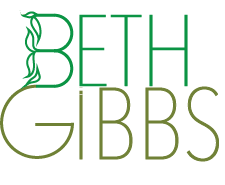ENLIGHTEN UP! a blogSelf-awareness stories: lighting our way to clarity, contentment and resilience in a complicated world.
|
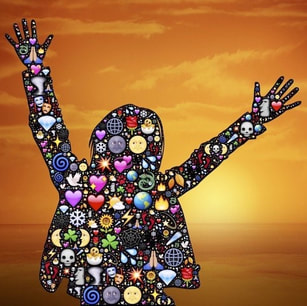 Guest post by Denyse LeFever Sometimes you need to pause to let everything sink in – Sebastian Vettal As I was sipping my morning coffee a few weeks ago, scrolling through my email to delete the accumulation of overnight junk mail, I paused on Maria Shriver’s Sunday Paper email. It was the first day of Spring and she was reflecting on how to make each day in life more meaningful. To make a point, she wrote that a friend told her, based on averages, how many years she had left in this lifetime. I quickly did my own calculation and concluded that for me….assuming I keep my diabetes in check, I may have fourteen years left in this lifetime. Gulp! I can’t deny it any longer…I am a senior, an elder, a medicare recipient. For over a decade, I’ve been the age that a recent Atlantic article calls: The Invisiblity of Older Women. My husband jokes with me that in my head, I am 40. This is a big improvement, because for decades I was 25. I think I moved up to 40 when I realized that I was becoming invisible. I no longer stood out as a young 20 or 30 something “gal” in a predominately white male career field. As I approached 45, I really liked this invisibility cloak. I didn’t have to worry about a lot of the things that were irritating when I was younger. Male customers no longer tried to “pick me up” at trade shows. (I usually needed someone else to point this out to me when this was happening as I was mostly oblivious). My “middle” age meant, I was unlikely to drop out of my job to have a baby. I was considered a promotable employee based on my work experience. (Yeah, I know, sometimes my promotions were strictly because a gender quota needed to be filled.) I breezed through my late 30s and early 40s focused on the day to day. Then, at about the age, I am now. My Dad received confirmation of something he long feared. He was developing the same symptoms that his Dad had 20 years prior. He was losing his memories. He lived the last decade and a half of his life, feeling and watching an aggressive worm nibble away at his brain. He described this metaphorical worm in the last poem that he wrote entitled At the Nadir of My Night. My family, and my Mom especially, suffered deeply as we watched my Dad slip away. His death 12 years ago, was a blessing. He no longer suffered from the prison of forgetfulness. I thought about 14 years of life. Will I spend my final decade in a brain fog, just like Dad? Just as I avoid confronting my chronological age, I also avoid acceptance of my genetic predisposition for diseases like Heart Disease, Diabetes and Alzheimer’s. In the final years of my Dad’s illness, I was diagnosed with Type 2 Diabetes (which is considered a pre-cursor for both Heart Disease and Alzheimer’s). My job and life were full. I ignored early warning signs of pending Diabetes. In my 30s, I recall my family doctor telling me – “Your pace and style of life are not healthy. Now is the time to think about the quality of your life, not the quantity.” When I hit my 40s, full of energy, with no symptoms of diabetes or heart disease, I felt like I was in the clear. I ignored the higher blood pressure readings and weight gain. Depression over my Dad’s illness, the increasing “invisibility” I was feeling in my work life and my type 2 diabetes diagnosis caused me to dive deeply into yoga. I focused first on reducing my sense of stress in life. My lifestyle habits and thinking patterns began to change. My yoga diversion also allowed me to place my mind and actions toward learning and healing rather than worry and depression. When I became a yoga teacher, I designed my classes for “senior” populations and/or those with chronic conditions. Although I was a member of both demographics, I didn’t see myself that way. One of my “senior” students told me she preferred the term “perennial” to senior. “Senior means you graduate from something. Perennial means you come back to bloom year after year.” I liked her thought. If I was a perennial, would I still be an invisible “older” woman? I didn’t care. Yoga teaches us to challenge our perceptions. Sometimes our thoughts and words can take us away from our “True Self.” My True Self will continue to bloom whether it’s visible or not. Using my yoga mindset and learning from my student, I decided I am a perennial. Some days are easier than others to be a perennial. When I read the Maria Shriver article, I wondered if I could be a perennial for the next 14 years. During the pandemic, I’ve been more aware of “senior moments” as I try to recall a story or fact when I communicate with others. I’ve been mediating daily during this crazy pandemic year. Meditation teaches us to focus on the pauses between thoughts. I took another sip of coffee. Then, it hit me. “I wasn’t having ‘senior moments.’ I was having inspirational pauses.” Over the next 14 years, assuming I am blessed with this longevity, I’ve decided this Invisible Woman will focus on being a perennial and enjoy the many inspirational pauses in between! Best wishes for a Happy Spring. Enjoy each day! 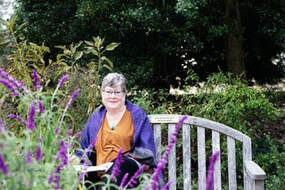 Denyse first discovered Yoga as a teen to alleviate stress and anxiety associated with taking standardized tests. She found both the gentle Hatha based practice and meditation to be helpful in easing her into adulthood. As she embarked on her over 30-year career in global business, she periodically returned to Yoga to maintain a sense of balance. Approaching her senior years, and after a diagnosis of Type 2 Diabetes, Denyse decided to take her casual interest in Yoga to a more professional in-depth study with a focus on yoga’s wellness benefits. Denyse is a certified Yoga Therapist and holds a certificate for 1000 Hours of Comprehensive Yoga Therapy Teacher Training. In 2020, Denyse took her yoga teaching on-line and has been teaching chair yoga, restorative yoga and Yoga Nidra classes on Zoom to a global community across the US and Europe. Check her out at: www.lavenderomwellness.com
3 Comments
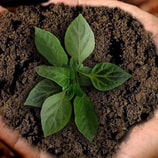 A popular nursery rhyme from the early 19th century suggests that we are made of many things, frogs, snails and puppy-dog tails,’ for boys, and ‘sugar, spice and everything nice,’ for girls. The bible says, ‘ashes to ashes, dust to dust,’ meaning that we come from dust are made of dust and will return to dust after transitioning from our five sense material world. In terms of the nursery rhyme, I’m hoping wiser heads have let that go. I personally know many sweet spicy men and froggy snail-like women. Although I understand the use of the word ‘dust’ I prefer the word earth. Dust to me is what you find under the sofa when you finally get around to cleaning up. Earth is what you plant seeds in to grow vegetables, plants and flowers. It’s a much pleasanter way to think of yourself whether you are a man or a woman, or place yourself at some other point on the rainbow of human expression. In the next several posts, I plan to explore what we’re made of and how to use those ingredients to enlighten up. Let’s start with earth. We can look at it through three lenses – physical, energetic and psychological. As matter, earth exists as a solid state that we can see, hear, smell, touch or taste. This includes our physical body and everything in and on it. It’s dirt, soil, and the things that grow out of it such as trees, mountains, the buildings we live and work in and the planet we live on. Earth is a homey word that connotes a foundation from which to grow and blossom. No wonder we call our planet — The Earth. As energy earth possesses qualities we need in order to keep ourselves balanced and healthy. At its core earth energy is the force that stabilizes and holds things together. It’s permanent, heavy, slow-changing, slow moving, downward flowing, dense, and enduring. Psychologically, we can think of earth as having qualities of safety, stability, security, nurturance and survival. To successfully connect with these qualities, we need to fully inhabit our earthly bodies with compassion and without judgment – no matter their condition or ability. An example of language that sharpens this connection is the phrase ‘stand your ground.’ Finding ways to stand our ground in these troubled times is a challenge whether due to race, religion, ability, gender, health issues, political affiliation, body image etc. It’s also hard to stand your ground energetically and psychologically if your basic physical needs have not been met. Consider Maslow’s hierarchy of human needs:
Having sufficient air, water, food and safety, establishes a personal root system that helps us grow toward positive social connections, self-esteem and self-actualization. Feeling comfortable and at home in your own skin can be an indication that your connection to earth through all three lenses is balanced. This is evident when you feel stable, compassionate or calm, and when you feel safe and connected to the physical world, your family, friends and support communities. The additional stress many of us deal with these days often manifests as issues that challenge our ability to keep this balance. In order to stand our ground we need to restore that all-important sense of safety and security. Here are two accessible practices that can help. 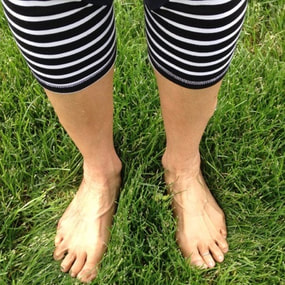 1. Grounding Earthing is the practice of grounding or connecting directly with the earth through skin contact with bare feet or hands. Earthing can encourage and deepen feelings of safety, security and connection. You can read more about the practice here (in an earlier blog post) and here (in an article at the Yoga for Healthy Aging blog). Those of us able to stand firmly on our own two feet, walk barefoot in the grass or on sand at the beach can experience grounding through direct connection with the earth. If we are able to transfer from standing to sitting or lying down we connect even more of our body to the earth. But what if you are unable to transfer up and down off the floor or connect your body directly to the ground? What if your feet go no further than wheelchair footrests or if parts of your body are missing or movement is limited due to surgery or a health condition? Where there is a will, there is always a way. Missing or nonfunctioning body parts can still be experienced energetically. If this is your lived experience, try the Roots Visualization instead. 2. Roots Visualization 1. Direct your attention to your legs and feet (physical or energetic) to sense a deeper connection to the earth, floor, or wheelchair footrests beneath you. 2. Begin to visualize roots growing from your body, starting from the base of the spine. Feel roots reaching down through your legs through the bottoms of your feet to pierce through the earth’s crust. 3. Visualize your roots branching and spreading, growing stronger and reaching deeper into the earth. Sense the strength, support, and the stability your branching roots send back to fill your entire body. 4. With each inhale begin to draw in strength, support, and stability. Allow the feeling to deepen your connection to the physical world and your place in it. 5. Draw the quality of grounding through the bones of your feet and legs to the base of your spine all the way up to the crown of your head. Feel your entire body safe, secure, stable and connected. You can shorten or lengthen the visualization as needed to stand your ground assertively, authentically, and confidently connecting to your world and earth in all of its forms. |
Archives
July 2024
AuthorBETH GIBBS started her yoga practice in 1968, four months after her son was born and she’s been practicing ever since. She currently teaches all levels therapeutic yoga classes for adults, and specialty classes for seniors in the Hartford, Connecticut area. Beth is a certified yoga therapist through the International Association of Yoga Therapists and is guest faculty at the Kripalu School of Integrative Yoga Therapy. She writes for the blogs, Yoga for Healthy Aging, and Accessible Yoga. Her master’s degree from Lesley University in Cambridge, MA is in Yoga Therapy and Mind/Body Health. Categories |
|
|
Enlighten Up! a Blog
|
Copyright © 2023 Beth Gibbs
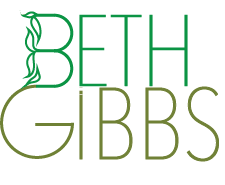
 RSS Feed
RSS Feed
